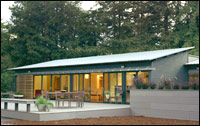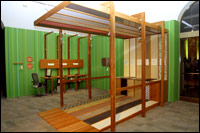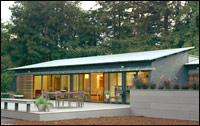Sometimes it feels tough to get through a day without despoiling the planet. The products most of us use come through a wasteful global production chain; discarding old stuff is cheaper than repairing it; and our energy supply is inefficient and hard on the earth. Making matters worse, most of this excess centers around the heartwarming center of our existence, the home: U.S. households are responsible for about a quarter of the country’s energy use.
So what to do? A new exhibit at Washington, D.C.’s National Building Museum puts green living in the spotlight, providing inspiration for those who dare to dream and a plethora of ways for the rest of us to counteract our wasteful habits.

The Glidehouse in its natural
habitat.
Photo: JMC Photography,
courtesy National Building Museum.
“The Green House: New Directions in Sustainable Architecture and Design” aims to show visitors how thoughtful choices — even small ones — can help conserve resources, save money, and support healthier lifestyles. With displays that are complemented by lectures, trips to renovation and construction projects, family programs, and a comprehensive website, the exhibit offers something for everyone.
Those who want to think big can explore an entire environmentally friendly house, which opens the exhibit and serves as a vivid illustration of what’s possible. The Glidehouse, designed by California architect Michelle Kaufmann, features sliding panels to regulate sunlight and ventilation; bamboo floors; recycled, toxin-free materials; and water- and energy-saving features including fluorescent lighting and a tankless water heater.
The exhibit profiles 20 other green houses from around the world. However, its organizers point out that building an entire house is just one way to go green. “The process can be small, at the evolutionary level, even if it’s recycling and renovation,” explains lead curator Donald Albrecht. “Making green houses can be incremental, and also stylish.”
Whether building a house or making small adjustments, how does one begin? That’s where the exhibit’s resource center comes in. The area is, as Albrecht puts it, “a sort of green Home Depot” that lets visitors get up close and personal with 60 different environmentally friendly materials (touching, according to the museum, is encouraged). It also provides tips, models, and diagrams about how best to implement the various options, which include floors of cork and bamboo, countertops made with recycled paper, composite board from sunflower-seed hulls, tiles from recycled aluminum and glass, and a toilet with dual-flush options.
“One decision, one feature can have all these different benefits, on air quality, ecosystem, biosphere, climate change, personal health,” says Jason Holstine, who served as a supplier for the exhibit. Holstine is founder and owner of the Amicus Green Building Center, located in an antiques district just outside of D.C. “We help [customers] integrate [green] thinking throughout the whole building process,” Holstine says of his store, which is crammed with tiles, paints, clays, granite slabs, and other materials. “There is no other business like this in the mid-Atlantic,” he adds, though he notes that such outlets are more common in the Western U.S.

Wood you like to spend time in the
resource room?
Photo: F.T. Eyre,
courtesy National Building Museum.
Noting that energy and electricity inflation is running about 30 percent a year, Holstine recommends as a first step replacing light bulbs with compact fluorescents or LEDs. Besides energy, “the other big inflation cost these days is in health,” he says. To reduce indoor air pollutants ranging from asbestos to allergens such as mold, mildew, and dust mites, Holstine and others recommend selecting paints, carpet, and other materials carefully, and making sure ventilation systems are properly maintained.
For those on a tight budget, energy-saving devices are the most obvious way to go green. “People understand the idea of weather sealing, good windows, efficient air conditioning,” explains Albrecht, adding that it’s easy to find products that meet the U.S. EPA’s Energy Star guidelines: “Everything now is somewhat more green than 40 years ago. If you have a pre-1970s air conditioner, you probably should buy a new one. It will pay for itself in the short run.”
Ultimately, says coordinating curator Reed Haslach, the exhibit’s organizers hope to convince visitors of the benefits — and ease — of going green. “The choice to sustainably build or renovate … gives people a personal sense of agency to both benefit the environment and make their houses healthier and more comfortable places,” she says.
In other words, there are good, solid reasons to choose this route. Or, as Albrecht told The Washington Post in May, “Going green does not mean going weird.”
“The Green House: New Directions in Sustainable Architecture and Design” runs through June 3, 2007, at which time it will begin a national tour. A companion book by the same name is available online. The National Building Museum is currently planning a follow-up exhibit on green communities.


